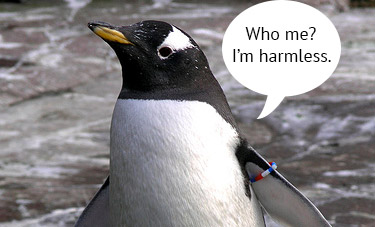The year was 2012. For some grey hat and black hat SEOs it was business as usual, quietly building links from blogs no one reads or even buying links from link networks. Unknowing (or knowing) small businesses dominated the SERPs above household name brands, ranking on page one for many target keywords. Then Google made two major updates called “Panda” and “Penguin” to their search algorithm (that thing that determines who ranks where), and the rest was history. Penguin mainly impacted incoming links and Panda mainly impacted page content.

A New Bird in Town
Like bad house guests, parts of Penguin and Panda are still with us today including a Penguin 2.1 update in October. Google released an entirely new engine called “Hummingbird” in late 2013 that includes many of the old updates as part of a new core engine designed to improve conversational searches.
Penguin in 2013
Fast forward to December 2013, and there are still many business owners feeling the impact from those Google updates from almost two years ago. There are, however, some websites that partially recovered from those updates. The fact is, many of the websites hit may never reach their pre-Penguin or pre-Panda levels for some time to come. Just like PED use inflated MLB baseball statistics, spam links inflated rankings that may never return. Having grossly inflated “rankings on steroids” before Penguin, the business is forced to earn good links over time which can take much longer than simply buying links from a link service.
Setting Client Expectations
As a consultant or agency, it’s important that you set the right expectations with your client. If you were managing the website during those updates, come clean with your tactics and explain what you’re going to do to help fix the situation. If you are inheriting a website from another agency or consultant, explain that it can be several months or perhaps a couple years before that website recovers. Even a partial recovery is better than no recovery. Hopefully you will take steps to make the most of other channels to help soften the blow from those updates. If you are improving user experience and adding value, the growth could exceed those pre-spam levels.
SEO Red Flags
If you are a client or business that has been hit by a Google update. Ask the agency or consultant working on your site to list activities and tactics. If they can’t come clean with what they are doing to improve your website in search results, it’s time to find a new agency. If you hear any of the following tactics in 2013, it’s also a red flag. Head for the hills!
- Directory link building (other than a couple high value directories like Yahoo or BOTW.org)
- Social bookmarking
- Guest blogging on irrelevant websites
- Submitting your website to search engines (this is a 1998 tactic)
- Ranking reports with meaningless keywords or one word keywords
- Lack of lead or conversion reporting
- Article submissions to article directories
- Press releases for the sake of press releases
- Poor quality articles or blog posts (you’ll know it when you read it)
- Little or no focus on social media marketing (Twitter, Google+, Facebook, etc)
Download Our Case Study
Interactive Cleveland has created a free case study featuring a B2C E-commerce client who was impacted by those 2012 updates and how they have partially recovered from those updates to grow their business. The focus was less on generating a ton of organic visits and more on attracting high quality visitors who were more likely to buy. By improving the user experience, removing spam links and replacing spam content with good content, we were able to see a dramatic turnaround a year later. Contact us if you have experienced the same problems and are looking for a solution to Google updates. We can help you build an effective strategy.
Other Google Penguin Recovery Stories
While researching the web on this topic, we also found other examples of Penguin and Panda recovery. Check out this list.
